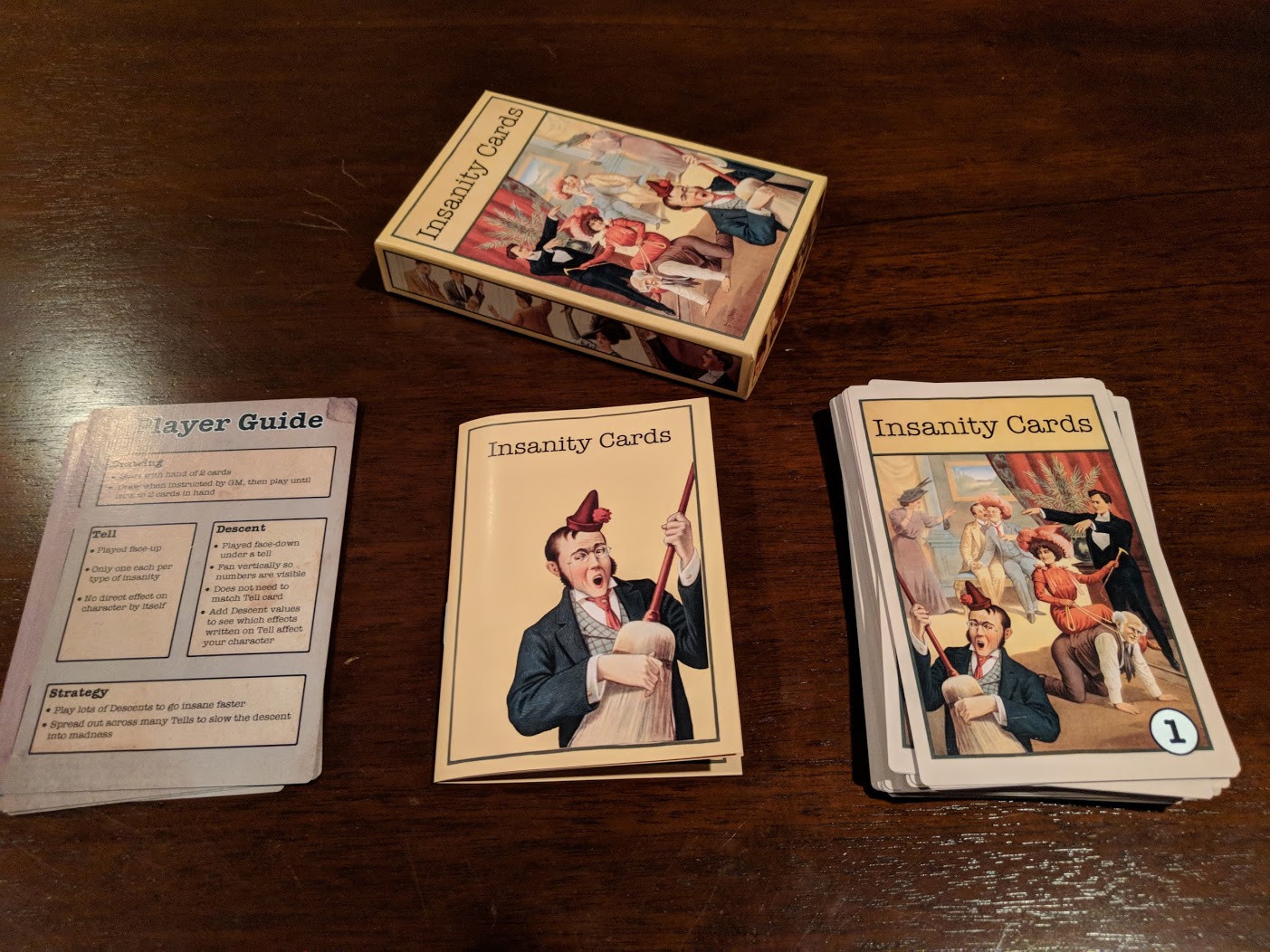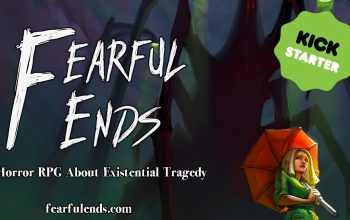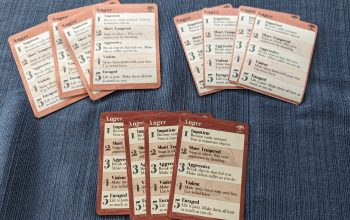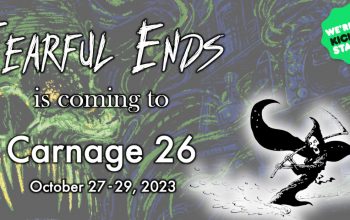
About a year ago I took Insanity Cards off of the market. I removed the print and play edition from DriveThruRPG and the various POD physical versions from GameCrafter. Every now and then I get a message from someone looking to buy a copy and wondering where they went. The answer I unfortunately have to give is that you simply can’t buy them anymore. However, fear not, the project is not completely dead. In fact, a new, bigger, better project is about to rise from its ashes…
But Why?
I took the project down because I was becoming increasingly aware of the issue around the representation of mental health in roleplaying games. I noticed a lot of games were simply removing sanity mechanics entirely, like WFRP 4e or Fate of Cthulhu. Other games were simply turning a blind eye. It caused me to take a critical look at my own product and question what I had created.
Now I feel very conflicted about this, because it’s not really a cut and dry situation. So I did my research. I read a couple thoughtful forum posts. I listened to the Mythcreants Podcast episode on mental health. Someone recommended to me Black Armada’s game Lovecraftesque which includes some great essays, including this one published on their site about Mental Health and Lovecraft. I even paid for a consult with a sensitivity reader to look at my existing product. Unsurprisingly the result was mixed, there were good and bad elements to my own work.
The Good
- My cards focus on direct, easy to roleplay prompts that represent symptoms of mental or emotional breaks. They never use real world clinical terms or suggest pat diagnosis for the player to try and enact.
- The mechanics put more power into the player’s hands. They get to choose what kind of reactions they will roleplay, and which they’d rather avoid.
- The use of Tells broadcasts to the rest of the table likely outcomes, giving players plenty of time to digest and opportunity to protest if they are concerned a specific direction a character is going may be objectionable.
The Bad
- The name is just not good. Most folks seem to agree that moving away from terms like “(in)sanity” and towards something like “mental stress” is a good idea.
- The trade dress is dated, I mean it’s public domain art from a hypnosis act of the early 1900’s.
- The text of the rules and advertising copy may have made overly light of a serious topic.
Paulthulhu
A while back I wrote up my list of house rules for using Savage Worlds with Insanity Cards for horror games, dubbed “Paulthulhu”. I knew of at least two other GMs that wanted to run exactly what I was running, so I felt the desire to document it. In the end I was quite surprised to discover just how much I had changed the system. I was starting to wonder if I shouldn’t just write a custom system of my own to go with the cards.
That was in my head when I discussed with my sensitivity reader the current state of the cards. He had a very interesting suggestion for me – why not embrace the sensitivity angle straight on? Rather than trying to massage the wording of text to sidestep anything offensive, why not actually write a set of rules that start out with a direct goal of providing a mental stress mechanic that is respectful of real world mental health issues?
It just seems like the obvious right choice. Looking at the good and bad lists above, it feels like as far as the guts of the mechanics go I’m already pretty close. So this is what I’ve set out to do. I took down the existing products as a means of doing no further harm, and since then I’ve been writing. What I’m looking at now is a full book of rules for running horror games with a central mechanic that I now call “Mental Stress Cards”. I imagine the end product could even be a small boxed set, including the rule book, a deck of cards, and a sample adventure. My goal is to be play-testing it this summer, and hopefully have it up on kickstarter for production before the end of the year. I will later kick myself for publicly setting hard deadlines like this.
How Can I Help?
If any of you dear readers and fans out there have experience running games with the old product, I’d love to hear from you. Tell me about what worked and what didn’t with the old cards. Any anecdotes about things you want to be sure I don’t accidentally cut, or cases where the cards did open the door to uncomfortable situations would be greatly appreciated.
I also need a name for this thing – Paulthulhu will not do. The game is meant to focus on short-duration games, one-shots or a handful of sessions, that focus on the collapse and destruction of the player characters. I think the closest comparable is Fiasco, though I suspect my game will be a little more morbid and less wacky. So if you have any thoughts on a clever name for such a game, by all means suggest away!
And keep watching this space for updates! I hope to repurpose this blog for posting updates on the project as I work on it. So hopefully you’ll see more from me on this topic here in the very near future.



Thanks for the insight into what your thought process/approach is. Clearly giving this a lot of thought.
I only got a chance to use them one in a Halloween one shot, and I fear I did not get enough cards into play for them to have an impact before the night was over.
So if it is going to be a system for One-shots, it might be good to give the GM some sort of number breakdown of average cards/triggers to get to X level of effect. Or general advise on how much to dial up or down?
Good point. I’ve already got a section on what kinds of player actions deserve cards, but general advice for the pacing of doling out cards would be a great thing to add.
I recently had an idea that for a standard 4-hour convention game, perhaps the number of cards should simply be “what hour is it?” Eg, anything that happens in the first hour gives you 1 card, anything in the second hour gives you two cards, etc. By the last hour of the game those 4 card events are going to really hit with a whollop.
Just thinking of a name communicating the player character experience, what about something like”Downward Spiral” or “Fearful Ends”?
Excellent, thank you. “The Downward Spiral” was in fact already on my list of potential names, thank you for the vote of confidence on that one. 🙂 I’m adding “Fearful Ends” to the list now.
Names: “Stressed” and “The Last Straw…” came to mind.
My group has used your original cards twice (both playing CoC) and had a lot of fun with them. They evoked more actual role-playing (instead of dice rolling) than I usually see in my group. I’ve felt much more comfortable using them than the Insanity rules in the CoC editions that I own, and felt them a better way of introducing mental stress into other RPGs. One of my players has schizophrenia – he particularly commented that he liked the cards and the way they worked. He’s not usually a CoC fan, and I’d say both the cards and my relaxed play style of CoC one-off games contributed to him being comfortable and having fun with them.
I really like the categories and level suggestions on the cards. I’d support better/differently worded rules, and new images. Even though you made light of mental illness (rules), you were still taking the issue seriously and presenting a much friendlier and sensitive version than older RPG’s.
Wow, thank you so much for sharing Tarmor! I’m really excited to hear that the cards are actually working for someone living with schizophrenia, that really makes me feel like I’m on the right path here. If you might be interested, I’d love to share early drafts with you and get your feedback, and/or set your group up with a playtest copy when I get to that point. It might be a while yet before I’m there, but drop me a line at paul @ paulsgameblog . com if you think you might be interested in that and we can discuss details.
Honestly, this is going to sound shallow (because it is), but the art and sense of lightheartedness around the old Insanity Cards is the main part of what turned me off from trying them out. To be fair, the snippets of actual mechanics that you’ve shared (either here or via WDM) always sounded reasonable, but the presentation kind of poisoned the well too much for my tastes, as someone who both has mental issues and likes to set a serious tone (though of course I can roll with funny moments as they come up in play…hell, I probably initiate half of them to signal that it’s ok to have some tension release in between dealing with heavy topics ?). So I’m looking forward to seeing how this project goes.
On a more constructive note, throwing out a spray of name ideas to hopefully help:
(Teetering) On The Brink
Final Steps
Break Me
Doom Awaits
Collapse
Mortality Clarified
A Gaze Returned
Ruin (Follows)
Tenebrous Dawn
We Fall
Umbral Moments
No Tomorrow
Hope Snuff (or Hope’s Not Enough, if you’d rather something that sounds more natural than some warped multi-medium wordplay ?)
(Bend, ) Don’t Break
(Limits of) Endurance
…always happens that you make a list and get more ideas as soon as you put it down ?
Fading Embers
Witness (Fragility/Humanity)
Wow, great suggestions, thanks Ash!
And I really appreciate the feedback on the mechanics vs. presentation of the old product. It’s very reassuring to hear that criticism repeated from multiple sources, it makes me feel like I might just be on the right path here. 🙂
I’m usually pretty bad at naming things, so I just threw out as many different appropriate-sounding words and forms as I could think of (without repeating earlier suggestions) to hopefully provide some inspiration.
Your heart’s in the right place, so as long as you follow its guide, you shouldn’t have much to worry about 🙂
I’ve always used your cards in my games of DDC (Dungeon Crawl Classics) which favours I think that mood of light hearted death. I posted a previous experience of taking a group into B4 the lost city too great effect! I love your insanity cards and I never play a game without them!! EVER!
I too had a schizophrenic in one group along with many transgender players. Two of the players fought a battle to the death because they both wanted a ventriloquists dummy to be their own. The victor cherished the fact that the dummy was covered in blood. Insanity cards optional? 🙂
I applaud your sensitivity to the current mental health crisis, but I am here to argue that your game aid helps in turning D&D into a cure for mental health issues and is neither a cause for it nor a flippant or dismissive poke and those who struggle.
FULL DISCLOSURE: I recently removed a zombie figurine from my undead blood bowl team because it had a noose around it’s neck. Suicide and lynching triggers have no place at a table with strangers these days.
TL;DR Maybe sitting with friends is the difference, at my table insanity cards have never been an issue. At a blood bowl tournaments I play against strangers and err on the cautious side of sensitivity.
Thank you so much for sharing! It’s really nice to hear folks using the cards that actually feel like they are helping more than hurting. I hope you’ll find the new cards just if not more enjoyable than the old ones.
Your cards list symptoms not disorders. So I feel as though they are fine.
You don’t say “you are depressed” or “you are suicidal” your cards say you see things that aren’t there.
It’s almost as if the cards were named “ineffective stress responses” you’d be totally fine. So it’s all in a name?
Thanks! I do kind of agree that it’s largely a branding issue. I think at their core the cards are a good way for allowing roleplay of mental collapse in a safe way. But I do think the light-hearted artwork and use of the term “Insanity” have to go.